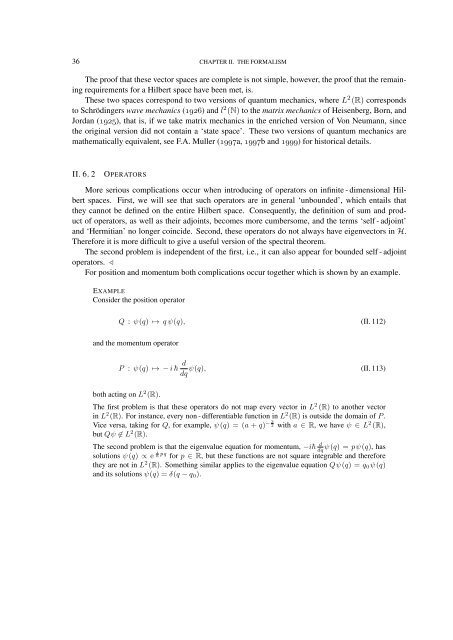FOUNDATIONS OF QUANTUM MECHANICS
FOUNDATIONS OF QUANTUM MECHANICS
FOUNDATIONS OF QUANTUM MECHANICS
Create successful ePaper yourself
Turn your PDF publications into a flip-book with our unique Google optimized e-Paper software.
36 CHAPTER II. THE FORMALISM<br />
The proof that these vector spaces are complete is not simple, however, the proof that the remaining<br />
requirements for a Hilbert space have been met, is.<br />
These two spaces correspond to two versions of quantum mechanics, where L 2 (R) corresponds<br />
to Schrödingers wave mechanics (1926) and l 2 (N) to the matrix mechanics of Heisenberg, Born, and<br />
Jordan (1925), that is, if we take matrix mechanics in the enriched version of Von Neumann, since<br />
the original version did not contain a ‘state space’. These two versions of quantum mechanics are<br />
mathematically equivalent, see F.A. Muller (1997a, 1997b and 1999) for historical details.<br />
II. 6. 2<br />
OPERATORS<br />
More serious complications occur when introducing of operators on infinite - dimensional Hilbert<br />
spaces. First, we will see that such operators are in general ‘unbounded’, which entails that<br />
they cannot be defined on the entire Hilbert space. Consequently, the definition of sum and product<br />
of operators, as well as their adjoints, becomes more cumbersome, and the terms ‘self - adjoint’<br />
and ‘Hermitian’ no longer coincide. Second, these operators do not always have eigenvectors in H.<br />
Therefore it is more difficult to give a useful version of the spectral theorem.<br />
The second problem is independent of the first, i.e., it can also appear for bounded self - adjoint<br />
operators. ▹<br />
For position and momentum both complications occur together which is shown by an example.<br />
EXAMPLE<br />
Consider the position operator<br />
Q : ψ(q) ↦→ q ψ(q), (II. 112)<br />
and the momentum operator<br />
P : ψ(q) ↦→ − i d ψ(q), (II. 113)<br />
dq<br />
both acting on L 2 (R).<br />
The first problem is that these operators do not map every vector in L 2 (R) to another vector<br />
in L 2 (R). For instance, every non - differentiable function in L 2 (R) is outside the domain of P .<br />
Vice versa, taking for Q, for example, ψ (q) = (a + q) − 3 2 with a ∈ R, we have ψ ∈ L 2 (R),<br />
but Qψ ∉ L 2 (R).<br />
The second problem is that the eigenvalue equation for momentum, −i d dq<br />
ψ (q) = pψ (q), has<br />
solutions ψ (q) ∝ e i pq for p ∈ R, but these functions are not square integrable and therefore<br />
they are not in L 2 (R). Something similar applies to the eigenvalue equation Qψ(q) = q 0 ψ(q)<br />
and its solutions ψ(q) = δ(q − q 0 ).
















